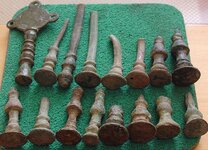CASPER-2
Gold Member
these finds were made by aquachigger the other day

they look mostly from the 1600 - 1700s
I am curious about the circled item
some think they are flintlock screws - but flintlock screws are usually iron/steel and
are threaded differently
the consensus from others that they are screws for furniture drawer plates
which I have seen screws from furniture from 1800s back that seem to match
my question is - does anyone know of a secondary purpose they may have been used
cause I have found like 5-6 of these and have seen many others posted on forums and found by friends
but they are found with no other hardware what so ever - and have found all mine in farm fields and a couple in fields that were old colonial fort sites and have to wonder if they used them for something else off of broken furniture
I guess they could be used as a tamper - but think there was some other purpose that they might have been carried - maybe they used them to clean their ears
any thoughts?

they look mostly from the 1600 - 1700s
I am curious about the circled item
some think they are flintlock screws - but flintlock screws are usually iron/steel and
are threaded differently
the consensus from others that they are screws for furniture drawer plates
which I have seen screws from furniture from 1800s back that seem to match
my question is - does anyone know of a secondary purpose they may have been used
cause I have found like 5-6 of these and have seen many others posted on forums and found by friends
but they are found with no other hardware what so ever - and have found all mine in farm fields and a couple in fields that were old colonial fort sites and have to wonder if they used them for something else off of broken furniture
I guess they could be used as a tamper - but think there was some other purpose that they might have been carried - maybe they used them to clean their ears
any thoughts?






 Well, more fodder for a cold winter morn HH
Well, more fodder for a cold winter morn HH

